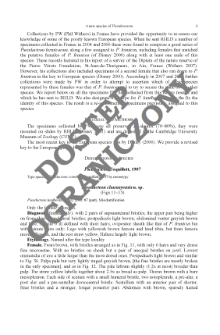
Object
Title: Life cycles of clausiliids of Poland - knowns and unknowns
Inny tytuł:
Annales Zoologici, vol. 58, no 4
Współtwórca:
Polska Akademia Nauk. Muzeum i Instytut Zoologii ; Fundacja "Natura optima dux"
Wydawca:
Miejsce wydania:
Opis:
Bibliogr. s. 879-880 ; S. 857-880 : il. ; 27 cm ; Nazwy taksonów w jęz. łac.
Typ obiektu:
Abstrakt:
Among the 24 native clausiliids, 15 were subject to laboratory observations.Eleven of them were found to be oviparous, three – egg retainers and one – ovoviviparous. Batches, containing most often one to about a dozen of partly calcified, ellipsoidal orspherical eggs, appeared usually in the spring and autumn (in non-hibernating individualsthroughout the year). Probably the main factors determining the onset of reproduction arehumidity and temperature while the photoperiod has no significant effect. The incubation period is ca. two weeks (room temperature), the hatching is synchronous or asynchronous. Cases of intra-batch and inter-batch cannibalism were observed. The minimum time fromhatching/birth till adult size is ca. 3–9 months and after further 5–8 months the snails start producing eggs/babies. Clausiliids are iteroparous. Anatomical studies on the developmentof the reproductive system show that just before lip completion the reproductive system is still in completely developed. Penis, epiphallus and spermatheca develop within the firstmonth after growth completion (which would indicate attainment of ability to copulate), andthe reproductive system becomes wholly mature only after a few months. The clausiliid development strategy is probably the following: the quickest possible growth and attainment of adult size, then development of the reproductive system and attainment of sexual maturity.
Czasopismo/Seria/cykl:
Tom:
Zeszyt:
Strona pocz.:
Strona końc.:
Szczegółowy typ zasobu:
Format:
Identyfikator zasobu:
Źródło:
MiIZ PAN, patrz sygn. czas. P.255, vol 58, no 4 ; MiIZ PAN, patrz sygn. czas. P.4314, vol 58, no 4 ; click here to follow the link
Język:
Język streszczenia:
Prawa:
Prawa zastrzeżone - dostęp ograniczony
Zasady wykorzystania:
Digitalizacja:
Muzeum i Instytut Zoologii Polskiej Akademii Nauk
Lokalizacja oryginału:
Biblioteka Muzeum i Instytutu Zoologii PAN
Dofinansowane ze środków:
Program Operacyjny Innowacyjna Gospodarka, lata 2010-2014, Priorytet 2. Infrastruktura strefy B + R ; Unia Europejska. Europejski Fundusz Rozwoju Regionalnego
Dostęp:
Object collections:
- Repozytorium Cyfrowe Instytutów Naukowych > Kolekcje Partnerów > Muzeum i Instytut Zoologii PAN > Czasopisma
- Repozytorium Cyfrowe Instytutów Naukowych > Kolekcje Partnerów > Muzeum i Instytut Zoologii PAN > Wydawnictwa MiIZ PAN > Annales Zoologici
- Repozytorium Cyfrowe Instytutów Naukowych > Piśmiennictwo > Czasopisma/Artykuły
Last modified:
2 paź 2020
In our library since:
5 maj 2016
Number of object content downloads / hits:
36
All available object's versions:
https://rcin.org.pl/publication/55796
Show description in RDF format:
Show description in RDFa format:
Show description in OAI-PMH format:
| Edition name | Date |
|---|---|
| Life cycles of clausiliids of Poland - knowns and unknowns / Maltz, Tomasz K. ; Sulikowska-Drozd, Anna | 2 paź 2020 |
Objects Similar
Korniushin, Alexei V.
Norris, M. L. Adams, C. E.
Poliński, Władysław Karol Aleksander (1885–1930)
Poliński, Władysław Karol Aleksander (1885–1930)
Poliński, Władysław Karol Aleksander (1885–1930)
Ermilov, Sergej Gennad'evič Łochyńska, Małgorzata Olszanowski, Ziemowit
Korniushin, Alexei V.
Brooks, J. E. Htun, P. T.

 INSTYTUT ARCHEOLOGII I ETNOLOGII POLSKIEJ AKADEMII NAUK
INSTYTUT ARCHEOLOGII I ETNOLOGII POLSKIEJ AKADEMII NAUK
 INSTYTUT BADAŃ LITERACKICH POLSKIEJ AKADEMII NAUK
INSTYTUT BADAŃ LITERACKICH POLSKIEJ AKADEMII NAUK
 INSTYTUT BADAWCZY LEŚNICTWA
INSTYTUT BADAWCZY LEŚNICTWA
 INSTYTUT BIOLOGII DOŚWIADCZALNEJ IM. MARCELEGO NENCKIEGO POLSKIEJ AKADEMII NAUK
INSTYTUT BIOLOGII DOŚWIADCZALNEJ IM. MARCELEGO NENCKIEGO POLSKIEJ AKADEMII NAUK
 INSTYTUT BIOLOGII SSAKÓW POLSKIEJ AKADEMII NAUK
INSTYTUT BIOLOGII SSAKÓW POLSKIEJ AKADEMII NAUK
 INSTYTUT CHEMII FIZYCZNEJ PAN
INSTYTUT CHEMII FIZYCZNEJ PAN
 INSTYTUT CHEMII ORGANICZNEJ PAN
INSTYTUT CHEMII ORGANICZNEJ PAN
 INSTYTUT FILOZOFII I SOCJOLOGII PAN
INSTYTUT FILOZOFII I SOCJOLOGII PAN
 INSTYTUT GEOGRAFII I PRZESTRZENNEGO ZAGOSPODAROWANIA PAN
INSTYTUT GEOGRAFII I PRZESTRZENNEGO ZAGOSPODAROWANIA PAN
 INSTYTUT HISTORII im. TADEUSZA MANTEUFFLA POLSKIEJ AKADEMII NAUK
INSTYTUT HISTORII im. TADEUSZA MANTEUFFLA POLSKIEJ AKADEMII NAUK
 INSTYTUT JĘZYKA POLSKIEGO POLSKIEJ AKADEMII NAUK
INSTYTUT JĘZYKA POLSKIEGO POLSKIEJ AKADEMII NAUK
 INSTYTUT MATEMATYCZNY PAN
INSTYTUT MATEMATYCZNY PAN
 INSTYTUT MEDYCYNY DOŚWIADCZALNEJ I KLINICZNEJ IM.MIROSŁAWA MOSSAKOWSKIEGO POLSKIEJ AKADEMII NAUK
INSTYTUT MEDYCYNY DOŚWIADCZALNEJ I KLINICZNEJ IM.MIROSŁAWA MOSSAKOWSKIEGO POLSKIEJ AKADEMII NAUK
 INSTYTUT PODSTAWOWYCH PROBLEMÓW TECHNIKI PAN
INSTYTUT PODSTAWOWYCH PROBLEMÓW TECHNIKI PAN
 INSTYTUT SLAWISTYKI PAN
INSTYTUT SLAWISTYKI PAN
 SIEĆ BADAWCZA ŁUKASIEWICZ - INSTYTUT TECHNOLOGII MATERIAŁÓW ELEKTRONICZNYCH
SIEĆ BADAWCZA ŁUKASIEWICZ - INSTYTUT TECHNOLOGII MATERIAŁÓW ELEKTRONICZNYCH
 MUZEUM I INSTYTUT ZOOLOGII POLSKIEJ AKADEMII NAUK
MUZEUM I INSTYTUT ZOOLOGII POLSKIEJ AKADEMII NAUK
 INSTYTUT BADAŃ SYSTEMOWYCH PAN
INSTYTUT BADAŃ SYSTEMOWYCH PAN
 INSTYTUT BOTANIKI IM. WŁADYSŁAWA SZAFERA POLSKIEJ AKADEMII NAUK
INSTYTUT BOTANIKI IM. WŁADYSŁAWA SZAFERA POLSKIEJ AKADEMII NAUK


































